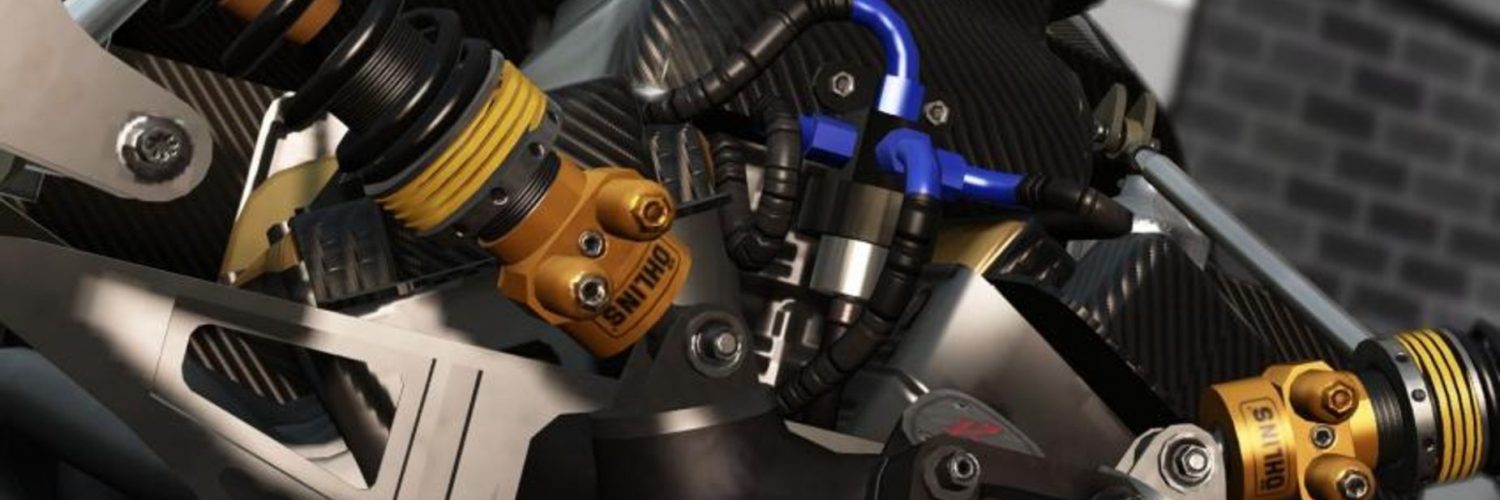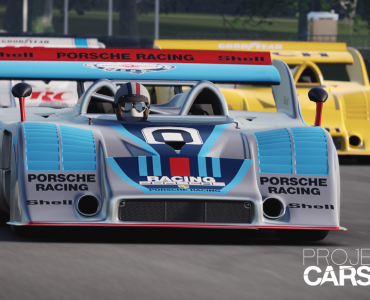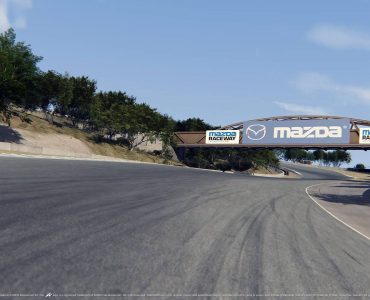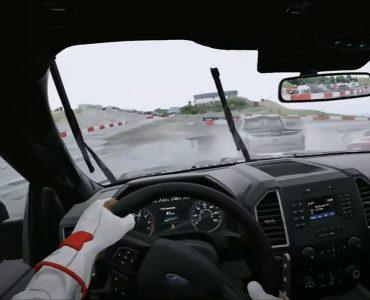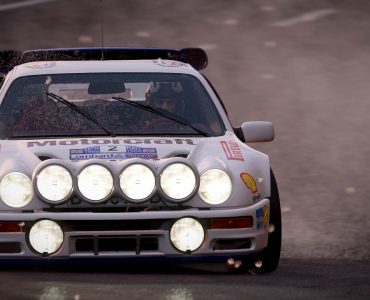While the knowledge in the video and the write-up below is tailored towards application in Project CARS 2, the knowledge as such applies to all simulations so make sure to watch whether you use Project CARS 2 or not.
STEERING RATIO
The Steering Ratio represents the number of degrees of steering wheel movement required for one degree of front wheel rotation, to turn the front wheels.
A higher Steering Ratio increases the amount of steering wheel movement needed, allowing for finer steering control. Decreasing the ratio will give more responsive steering, decreasing the amount of input needed, and making the car more sensitive to steering input and more suitable for tighter and twister circuits.
CASTER ANGLE
Caster Angle adjusts the side-view angle of the steering axis, with a Positive Caster Angle pointing the axis rearward at the top.
Positive Caster Angle will make the car more stable at high speeds and will increase camber gain with steering. Using too much positive Caster Angle will increase steering effort, making the car feel heavier and less responsive. Using a lower, positive Caster Angle will reduce both steering effort and jacking of the chassis with steering angle, and make the car more responsive upon initial turn in.
Most cars are not particularly sensitive to caster settings, so it???s best used in conjunction with other settings such as Camber Angles.
CAMBER ANGLE
Camber Angle adjusts the angle of the wheel on the vertical axis, from a front-viewing angle, with negative Camber pointing the top of the wheel inward on the car.
Increasing the Camber Angle of the wheel can improve the car’s cornering by maximising the tyre???s contact patch through a turn. Decreasing the Camber Angle of the wheel can improve acceleration and braking in a straight line, but comes at the detriment of cornering ability.
Aim for 5-10 degrees in temperature difference across the width of the tyres surface, with the inside third being the hottest and the outside being coolest.
TOE-IN ANGLE
Toe-In Angle adjusts the angle of the tyres pointing inward or outward from a top-down view.
Using Positive Toe-In (pointing the leading edge of the tyres inward towards each other) will make both wheels generate force against each other which gives better straight line stability, but at the expense of responsiveness. Using Negative Toe-In (pointing the leading edge of the tyres away from each other) will do the opposite, improving responsiveness and cornering ability, but making the car less stable in a straight line.
More negative or positive Toe Angle has an effect on tyre temperatures and also wear: as greater negative or positive Toe Angle increases the amount the tyres scrub across the track surface.
RIDE HEIGHT
Ride Height allows you to adjust the height of the car above the track surface. Generally, the lower the better as it will lower the cars centre of gravity, add mechanical grip, increase overall stability, and improve aerodynamic performance.
Lowering it too however far reduces the amount of travel before the suspension or underside of the car bottoms-out on bumpy tracks, resulting in the car becoming unsettled. Adjust the front and rear Ride Heights to find the right balance for the track and also the car, as it can be powerful for tuning the aerodynamics.
Flat-bottom cars benefit from forward rake (higher ride height at the rear) for increased downforce, particularly at the front axle. Cars with ground-effect tunnels tend to prefer a lower and more neutral ride height front-to-rear. Keep in mind that Ride Height should be tuned with speed in mind, as it will change at higher speeds when aerodynamics ???push??? the car down. Although the car may have rake in the setup, at high speed, the aero??? loads could be pushing things away from the desired position.
SPRING RATE
Changing the Spring Rate allows the tuning of the vehicle???s responsiveness and the attitude of the car through corners, leaning more towards either aerodynamic grip, or mechanical grip.
Increasing Spring Stiffness will result in quicker, more responsive handling, and allow the car to run lower for better aerodynamics. However, this can also both decrease tyre grip, and increase tyre wear. Decreasing Spring Stiffness will make the chassis move around a little more, allowing it to maintain better contact with the track surface on bumpy tracks and increasing mechanical grip. However, this will require higher ride heights which, in turn, will decrease aerodynamic grip in higher speed turns.
Adjust the front and rear Spring Rates to find the right balance for the track, the car, and your personal driving style. Having a softer rear decreases oversteer, but having it too soft could make it feel lazy and reluctant to rotate through a corner. It???s generally best to adjust the front and rear Spring Rates together.
ANTI-ROLL BAR
Adjustment of the Anti-Roll Bar allows you to control the amount of lateral chassis roll the car has when going through a turn.
Increasing the stiffness of the Anti-Roll Bar will keep the car more level in a turn and sharpen cornering response, but can potentially cause the inside wheels to lift off the ground in high-load corners. Decreasing the stiffness and running the Anti-Roll Bar softer will let the car roll more, increasing mechanical grip as more weight transfers to the outside tyres through a turn.
The Anti-Roll Bars are a useful chassis balancing tool. More roll resistance at the front (stiffer front and softer rear bars) can cause understeer, while more roll resistance at the rear can cause oversteer. A good rule of thumb for race cars is to set the Anti-Roll Bars such that the inside front tyre is just barely touching the track surface during high cornering loads.
For faster and smoother tracks, running stiffer Anti-Roll Bars can help maximise the aerodynamic grip by providing stable ride heights. For slower, bumpier, tighter tracks, running softer Anti-Roll Bars will increase mechanical grip.
TRACK BAR
The Track Bar, or Panhard Bar, connects the chassis of the car to a solid rear axle. Adjusting the connection points changes how cornering forces are transferred from the chassis to the tyres.
Lowering the right side mounting point, without changing the left, means cornering forces from turning left will add grip on the rear axle, tightening the handling on corner entry. Raising the right side will generally loosen the car, and add oversteer during left-hand corners. The opposite happens for right-hand turns in both cases.
The Track Bar also sets the rear roll resistance, much like an anti-roll bar. Higher average Track Bar gives more roll resistance, while a lower Track Bar acts as a softer anti-roll bar.
For road courses, it is best to keep the values of the Track Bar equal on both the left- and right-hand sides of the car.
???3RD SPRING
The 3rd Spring controls the vertical chassis movement of the car when both wheels are moving upward from suspension compression due to driver input, downforce levels, and bumps on the track. This is particularly useful in high-downforce cars as it allows the car to handle the loads generated at high-speed without the need to use excessively stiff springs on each corner.
Increasing the 3rd Spring stiffness will resist vertical movement at that end of the car, potentially creating a more stable aerodynamic platform, but at expense of mechanical grip. Softening or removing the 3rd spring can improve mechanical grip, but risks the car bottoming out at high-speed and may allow chassis movement, which will reduce aerodynamic performance.


